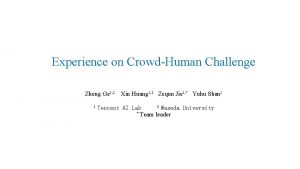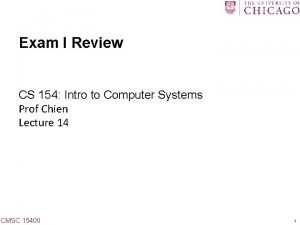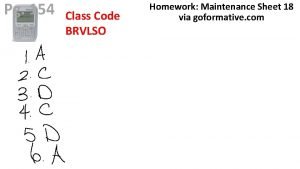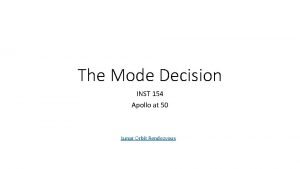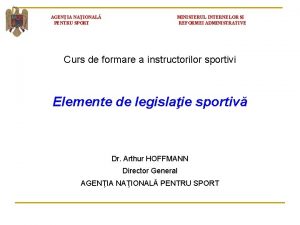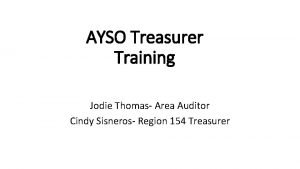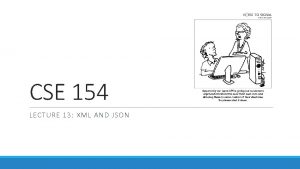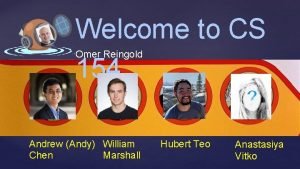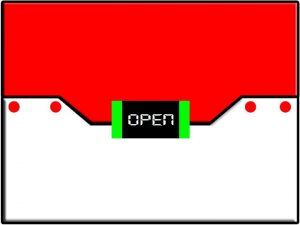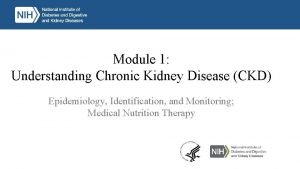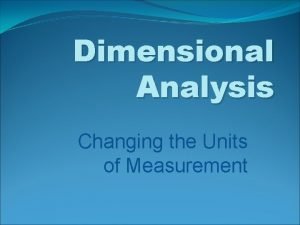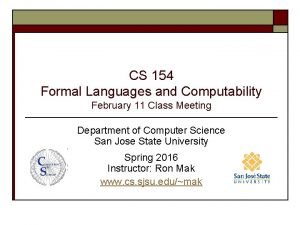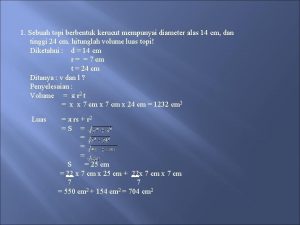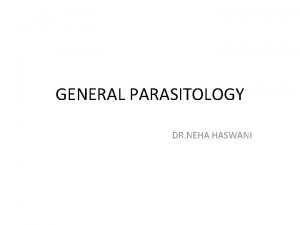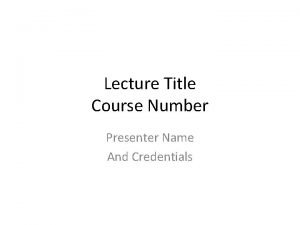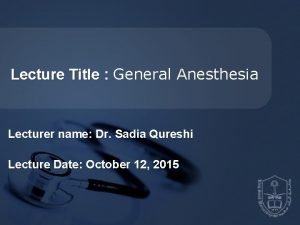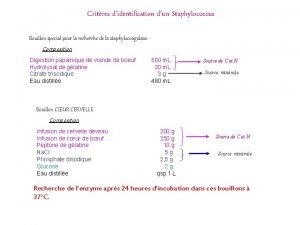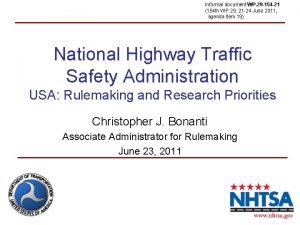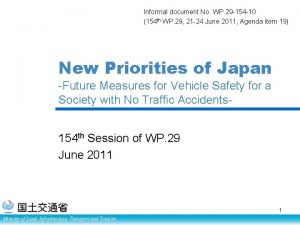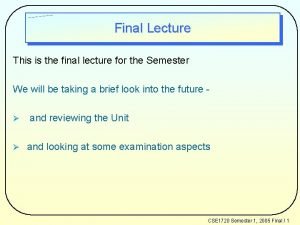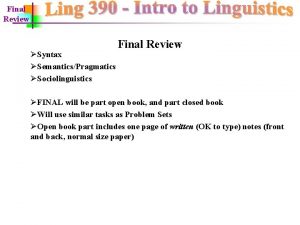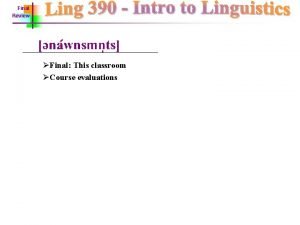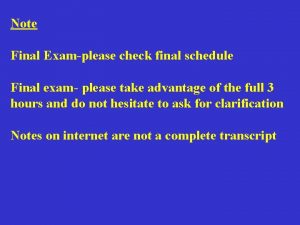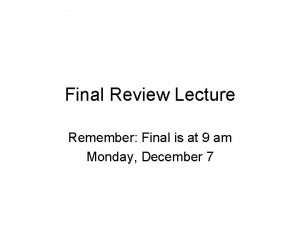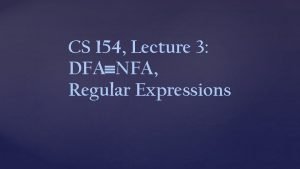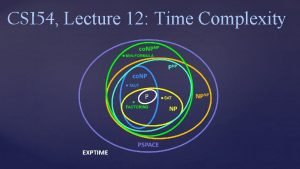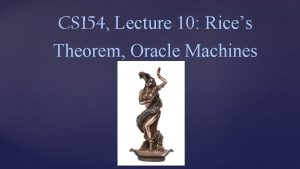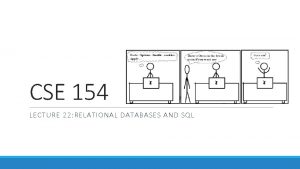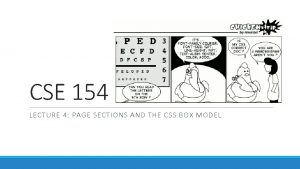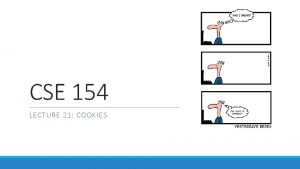CS 154 Lecture 18 1 CS 154 Final























- Slides: 23

CS 154, Lecture 18: 1

CS 154 – Final Exam Thursday December 12, 3: 30 -6: 30 pm location: TBD You’re allowed one double-sided sheet of notes Exam is comprehensive (but will emphasize post-midterm topics) Practice final and solutions on Piazza 2

Evaluate CS 154 Your Input Really Matters 3

Chapter I Finite Automata (40 s-50 s): Very Simple Model (constant memory) • Characterize what can be computed (through closure properties) • First encounter: non-determinism (power of verified guessing) • Argue/characterize what cannot be computed • Optimization, learning More modern (algorithmic and complexity-theoretic) perspective: streaming algorithms, communication complexity

Chapter II Computability Theory 30’s – 50’s Very Powerful Models: Turing machines and beyond (Un)decidability – what cannot be computed at all • Foot in the door – an unrecognizable language • Many more problems, through reductions • Hierarchy of exceedingly harder problems The foundations of mathematics & computation Kolmogorov complexity (universal theory of information)

Chapter III Complexity Theory: 60’s – Time complexity, P vs. NP, NP-completeness • Non-determinism comes back • Our foot in the door – SAT, a problem that is likely hard to compute • Many more problems through (refined) reductions • An hierarchy of hard problems Other Resources: space, randomness, communication, power, … Crypto, Game Theory, Computational Lens

Computing: “evolution of an environment via repeated application of simple, local rules” Somebody

Computational Lens

Hitchhiker's Guide to the Galaxy The Answer To Life, Universe and Everything:

Computational Game Theory Markets computing an equilibrium. Simple dynamics (best response)? Bounded Rationality: Prisoners Dilemma Repeated Games, infinite, finite Backward Induction Finite Automata Always Cooperate, Always Defect, Tit for Tat, Trigger

Limited Resources

Factoring & One-Way Functions Given two primes P and Q easy to compute N=PQ. For random such N, assume it is hard to find P and Q. Special case of One-Way Functions (the most basic cryptographic primitives). Random Instances of SAT that are hard Zero-Knowledge Proofs Hardness of learning Pseudorandom Generators Deterministically increasing entropy Randomness is weak

MAX-SAT Max-SAT = given a cnf formula how many clauses can be satisfied? A maximization problem: satisfy the most clauses Can always satisfy a constant fraction of all the clauses. Specifically: When all clauses have at least 3 unique literals, can satisfy at least 7/8 of all clauses (how? ) 7/8 of clauses in optimal solution ( a 7/8 -approximation). Can we approximate MAX-SAT up to any constant < 1? Can we solve Max-3 SAT with (7/8+eps)-approximation? Not if P NP For other problems no constant-approximation is likely - (clique n 1 eps)

The PCP Theorem For some constant > 0 and for every language L NP, there exists a polynomial-time computable function f that maps every input x into a 3 cnf formula f(x) s. t. • If x L then f(x) SAT • If x L then no assignment satisfies more than (1 - ) fraction of f(x) clauses. sufficiently good approximation of MAX-SAT implies P=NP (for tight inapproximability need better PCP theorem)

PCPs = Probabilistically Checkable Proofs Alternative (equivalent) statement of PCP Theorem (informal): Every statement that has a polynomial-time verifiable proof has such a proof where the verifier only reads O(1) bits of the proof such that [perfect completeness]: if the statement is correct accept with Probability 1 [soundness]: if the statement is false reject with probability 0. 99 Example of the power of randomness (probabilistically

What can we Prove? Every problem in NP has a short and easy to verify proof How about co. NP? Can a prover P convince a verifier V that there is no k-clique? How about PSPACE? Can P convince V that there is a winning strategy for white from a particular position? Yes!! If we add interaction!

Interactive Proofs PCPs add randomness to proofs, what if we also add interaction? Accept/Reject Interactive Proofs can be used to prove membership in powerful (PSPACE) languages. For example: V knows a winning Chess strategy: IP=PSPACE

Graph Non-Isomorphism A graph G and H are isomorphic if can rename vertices of G to get H (the mapping is called isomorphism). Graph Isomorphism = {(G, H)| G and H are isomorphic} Graph Non-Isomorphism = {(G, H)| G and H are not isomorphic} Graph Isomorphism in NP but can we prove that G and H are not isomorphic? We will see a simple interactive proof

Interactive Proof for Graph Non-Isomorphism H c Accept iff c = b

Zero-Knowledge (Interactive) Proofs PCPs add randomness to proofs, what if we also add interaction? Accept/Reject

IP for Non-Isomorphism is ZK (for semi-honest verifier) H c Accept iff c = b

Where is Waldo?

26
 01:640:244 lecture notes - lecture 15: plat, idah, farad
01:640:244 lecture notes - lecture 15: plat, idah, farad Senet154
Senet154 Cs 154 uchicago
Cs 154 uchicago Inst-154
Inst-154 Al baqarah 154-157
Al baqarah 154-157 Cr part 154
Cr part 154 Cse 154
Cse 154 Homework 154
Homework 154 Inst154
Inst154 Ordinul 154 din 2004
Ordinul 154 din 2004 Ayso region 154
Ayso region 154 Cse 154
Cse 154 Cs 154 stanford
Cs 154 stanford Dodo akan memberi kado ulang tahun buat desi
Dodo akan memberi kado ulang tahun buat desi Efrona
Efrona A person's weight is 154 pounds convert this to kilograms
A person's weight is 154 pounds convert this to kilograms Cs 154 sjsu
Cs 154 sjsu Sebuah kerucut mempunyai
Sebuah kerucut mempunyai Aim of health psychology
Aim of health psychology General parasitology lecture notes
General parasitology lecture notes Natural language processing nlp - theory lecture
Natural language processing nlp - theory lecture Lecture name
Lecture name Anesthesia complications
Anesthesia complications Pastorex staph plus schema
Pastorex staph plus schema

